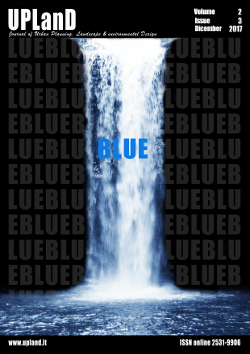Toward resilient public places on the waterfornt
Main Article Content
Abstract
The contemporary city waterfront areas could gather a strategic and multifunctional role, as a public place to the people wellness, as well as a resilient management of floods caused by climate changes. The international scenario presents many re-appropriation processes of urban waterfront that have been realized by reconversion of decommissioned port areas: the New York waterfront plan has a great relevance, such as Brooklyn Bridge Park, which represents a paradigm of the new concept of urban public place.
The design of the park aims to face the urban situations in order to mitigate their conflicts as well to find a sustainable aesthetic where the process of re-appropriation and awareness of the relationship with water is intended as an element to carry again nature in the city. The park should be much more performing compared to those of the past, not anymore an aesthetical improvement or an escape from the context but an escape into the city, including in it the urban fragments whose surrounds it.
Downloads
Article Details

This work is licensed under a Creative Commons Attribution-NonCommercial-NoDerivatives 4.0 International License.
Authors who publish with this journal agree to the following terms:- Authors retain copyright and grant the journal right of first publication with the work simultaneously licensed under a Creative Commons Attribution License that allows others to share the work with an acknowledgement of the work's authorship and initial publication in this journal.
- Authors are able to enter into separate, additional contractual arrangements for the non-exclusive distribution of the journal's published version of the work (e.g., post it to an institutional repository or publish it in a book), with an acknowledgement of its initial publication in this journal.
- Authors are permitted and encouraged to post their work online (e.g., in institutional repositories or on their website) prior to and during the submission process, as it can lead to productive exchanges, as well as earlier and greater citation of published work (See The Effect of Open Access).
References
Calcagno Maniglio, A. (1983) Architettura del Paesaggio Evoluzione storica, Calderini, Bologna
Dinkins, D. N. (1992) New York City Comprehensive Waterfront Plan – Reclaiming the City’s Edge, NYC DCP 92-27
Emoto, M., (2007) Il miracolo dell'acqua, Il Punto d'Incontro, Vicenza
Gwang-Won Kim, MS, Gwang-Woo Jeong, PhD, Tae-Hoon Kim, MS, Han-Su Baek, MS, Seok-Kyun Oh, PhD, Heoung-Keun Kang, MD, Sam-Gyu Lee, MD, Yoon Soo Kim, PhD, and Jin-Kyu Song, PhD, (2010), Functional Neuroanatomy Associated with Natural and Urban Scenic Views in the Human Brain: 3.0T Functional MR Imaging, www.ncbi.nlm.nih.gov/pmc/articles/PMC2930158/
Hurricane Sandy Rebuilding Task Force (2013) Hurricane Sandy Rebuilding Strategy, stronger communities, a resilient region, U.S. Department of Homeland Security, FEMA.gov
Kuitert, W., (edited by), (2008), “Transforming with water” IFLA2008 Proceedings of the 45th World Congress of the International Federation of Landscape Architects, Blauwdruk and Techne, Wageningen, Nederlands
N.Y.C. Mayor’s Office of Recovery and Resiliency (2017) Preliminary Climate Resiliency Design Guidelines, http://www1.nyc.gov/site/orr/index.page
Nichols, W. J. (2014) Blue Mind: the surprising science that shows how being near, in, on, or under water can make you happie, helthier, more connected, and better at what you do, Little, Brown & Company, New York
Quirk, V. (2014) The BIG U: BIG’s New York City Vision for Rebuilt by Design, www.archdaily.com
Roach C. (2011) Reinventing Public Places in NYC: Brooklyn Bridge Park, https://dirt.asla.org/
Sessarego, A. (2014) “Le aree dismesse: da criticità ad opportunità per lo sviluppo del paesaggio urbano” in Balletti, F., Ghersi, A., Paesaggio Urbano tra residui e risorse, FrancoAngeli, Milano, pp. 79-84
Sessarego, A. (2016) “Verso uno spazio pubblico del waterfont: recenti realizzazioni di architettura del paesaggio” in A. Ghersi, A.Sessarego, LA CITTÀ E L’ACQUA Progetti per un nuovo paesaggio accogliente, AltraAlinea edizioni, Firenze 2016, pp. 22-39
Whinston Spirn, A., “Reading the waterlines”, in Kuitert, W. (edited by) (2008) Transforming with water IFLA2008 Proceedings of the 45th World Congress of the International Federation of Landscape Architects, Blauwdruk and Techne, Wageningen, Nederlands, pp.146-147

